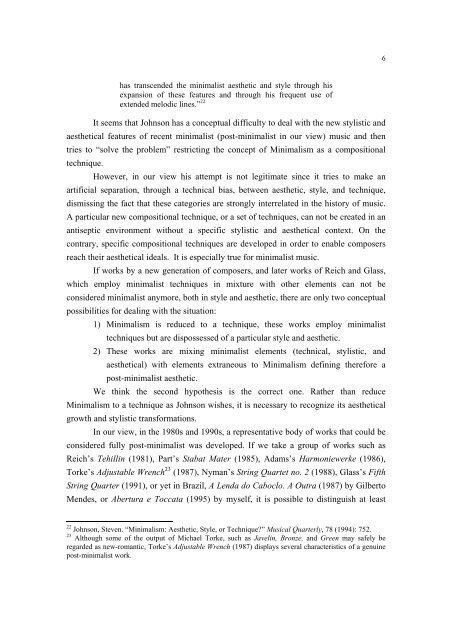Minimalism and Post Minimalism - Dimitri Cervo
Minimalism and Post Minimalism - Dimitri Cervo
Minimalism and Post Minimalism - Dimitri Cervo
Create successful ePaper yourself
Turn your PDF publications into a flip-book with our unique Google optimized e-Paper software.
has transcended the minimalist aesthetic <strong>and</strong> style through his<br />
expansion of these features <strong>and</strong> through his frequent use of<br />
extended melodic lines.” 22<br />
It seems that Johnson has a conceptual difficulty to deal with the new stylistic <strong>and</strong><br />
aesthetical features of recent minimalist (post-minimalist in our view) music <strong>and</strong> then<br />
tries to “solve the problem” restricting the concept of <strong>Minimalism</strong> as a compositional<br />
technique.<br />
However, in our view his attempt is not legitimate since it tries to make an<br />
artificial separation, through a technical bias, between aesthetic, style, <strong>and</strong> technique,<br />
dismissing the fact that these categories are strongly interrelated in the history of music.<br />
A particular new compositional technique, or a set of techniques, can not be created in an<br />
antiseptic environment without a specific stylistic <strong>and</strong> aesthetical context. On the<br />
contrary, specific compositional techniques are developed in order to enable composers<br />
reach their aesthetical ideals. It is especially true for minimalist music.<br />
If works by a new generation of composers, <strong>and</strong> later works of Reich <strong>and</strong> Glass,<br />
which employ minimalist techniques in mixture with other elements can not be<br />
considered minimalist anymore, both in style <strong>and</strong> aesthetic, there are only two conceptual<br />
possibilities for dealing with the situation:<br />
1) <strong>Minimalism</strong> is reduced to a technique, these works employ minimalist<br />
techniques but are dispossessed of a particular style <strong>and</strong> aesthetic.<br />
2) These works are mixing minimalist elements (technical, stylistic, <strong>and</strong><br />
aesthetical) with elements extraneous to <strong>Minimalism</strong> defining therefore a<br />
post-minimalist aesthetic.<br />
We think the second hypothesis is the correct one. Rather than reduce<br />
<strong>Minimalism</strong> to a technique as Johnson wishes, it is necessary to recognize its aesthetical<br />
growth <strong>and</strong> stylistic transformations.<br />
In our view, in the 1980s <strong>and</strong> 1990s, a representative body of works that could be<br />
considered fully post-minimalist was developed. If we take a group of works such as<br />
Reich’s Tehillin (1981), Part’s Stabat Mater (1985), Adams’s Harmoniewerke (1986),<br />
Torke’s Adjustable Wrench 23 (1987), Nyman’s String Quartet no. 2 (1988), Glass’s Fifth<br />
String Quarter (1991), or yet in Brazil, A Lenda do Caboclo. A Outra (1987) by Gilberto<br />
Mendes, or Abertura e Toccata (1995) by myself, it is possible to distinguish at least<br />
22 Johnson, Steven. “<strong>Minimalism</strong>: Aesthetic, Style, or Technique?” Musical Quarterly, 78 (1994): 752.<br />
23 Although some of the output of Michael Torke, such as Javelin, Bronze, <strong>and</strong> Green may safely be<br />
regarded as new-romantic, Torke’s Adjustable Wrench (1987) displays several characteristics of a genuine<br />
post-minimalist work.<br />
6


